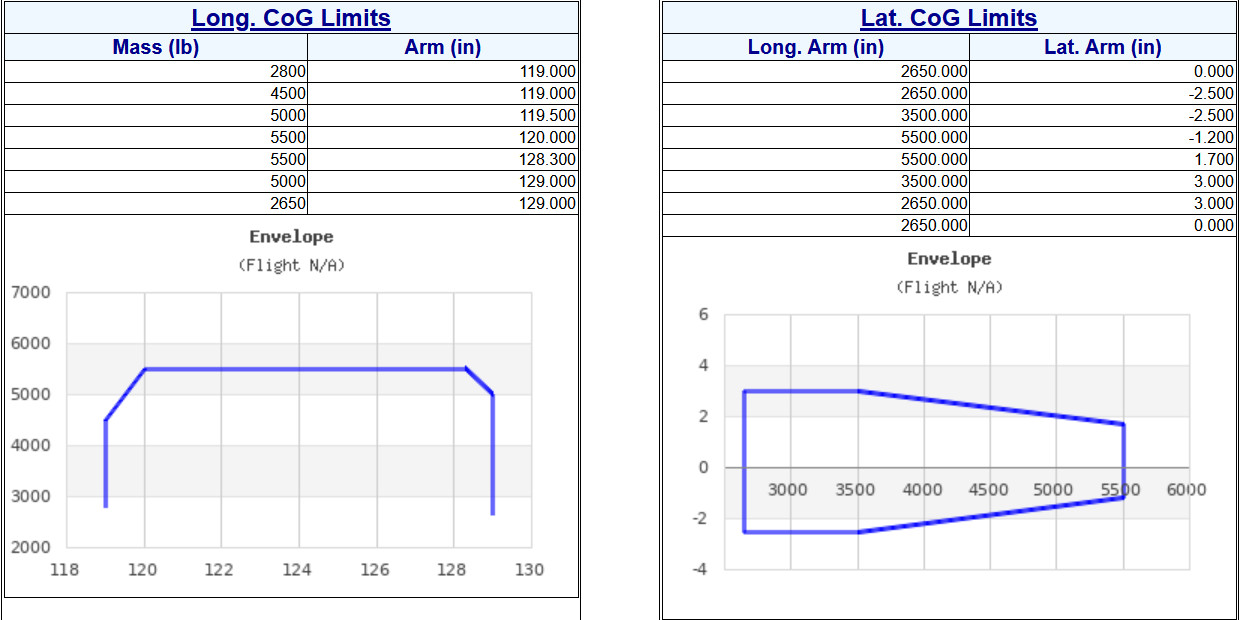Aircraft Types
Aircraft Types
Click on "Maintain Type" to view the Type list. The plus icon ![]() can be used to add a type. For each type the necessary fields are:
can be used to add a type. For each type the necessary fields are:
- Type Name
- ICAO Type Name
- Manufacturer
- Description
- Mass and Balance Type - select the type of mass and balance to calculate for this aircraft type. The options here are
- No Mass and Balance : disable the mass and balance calculations. The system will not force compliance to a mass and balance envelope during the flight authorisation screens. Pilots must ensure that they comply with loading restrictions for the aircraft.
- Longitudinal Mass and Balance - the system will enforce longitudinal mass and balance for the aircraft. This is the typical setting for fixed wing aircraft
- Both (lat x long) - the system will enforce both longitudinal and lateral mass and balance, where the lateral envelope is plotted with lateral arm on the Y axis and longitudinal arm on the X axis
- Both (lat x mass) - the system will enforce both longitudinal and lateral mass and balance, where the lateral envelope is plotted with lateral arm on the Y axis and mass on the X axis
Against each type you also need to enter necessary data to support the mass and balance calculations for the flight authorisation sheet.
Mass and Balance Stations
You need to enter the various seat stations as "seat1", "seat2", "seat3" and "seat4".
You can then add any additional stations you may require, for example "baggage", "doors", "camera rigs" etc. Note that for each additional station you can optionally enter a "Fixed weight". If you enter a fixed weight then the flight autho sheet will display the station with a tick-box next to it - the pilot simply needs to indicate if the extra station is there or not. So, for example, the basic empty mass of a Robinson R44 includes all of the doors, but the doors can be removed for a flight. If you include a station called "Door : Right Front : Removed" with correct arm settings for the door, and a fixed weight of -7.5lbs. Then, on flight authorisation, the pilot will have the option to tick the box next to "Door : Right Front : Removed" and the system will calculate the net effect of removing a 7.5lb door from the overall loading profile for the aircraft.
For each station the station description and arm are mandatory fields. The weight limit and fixed weight fields are optional.
Please enter arms in inches and weights in lbs.
Fuel Loading
The system can cope with any fuel tank configuration where the fuel is burned in a predictable fashion. Where fuel can be transferred from one tank to another (or used from various tanks at will) during a flight the system can not calculate a fuel load. For all predictable fuel burn conditions you should load the fuel loading table with the average arm of all of the tanks for each given fuel load. The example here indicates the fuel loading table for a Robinson R44 helicopter. This has two tanks (main and aux) each with it's own longitudinal and lateral arms. Fully loaded the arm is at 104.5" and lateral arm is at -3.58". As fuel burns off the overall fuel loading arm moves aft, and left such that when the aux tank is empty the remaining fuel in the main tank is at 106" and -13.5".
C of G Limits
You need to enter the coordinate reference points for the lines that make up the CofG limits graph for the aircraft type.
Enter the coordinates of each of the points on the CofG graph where the lines change direction.
Note: Please ensure that you start at the bottom left hand corner of the graph and proceed clockwise from there.

